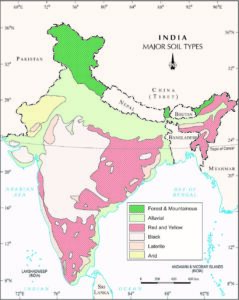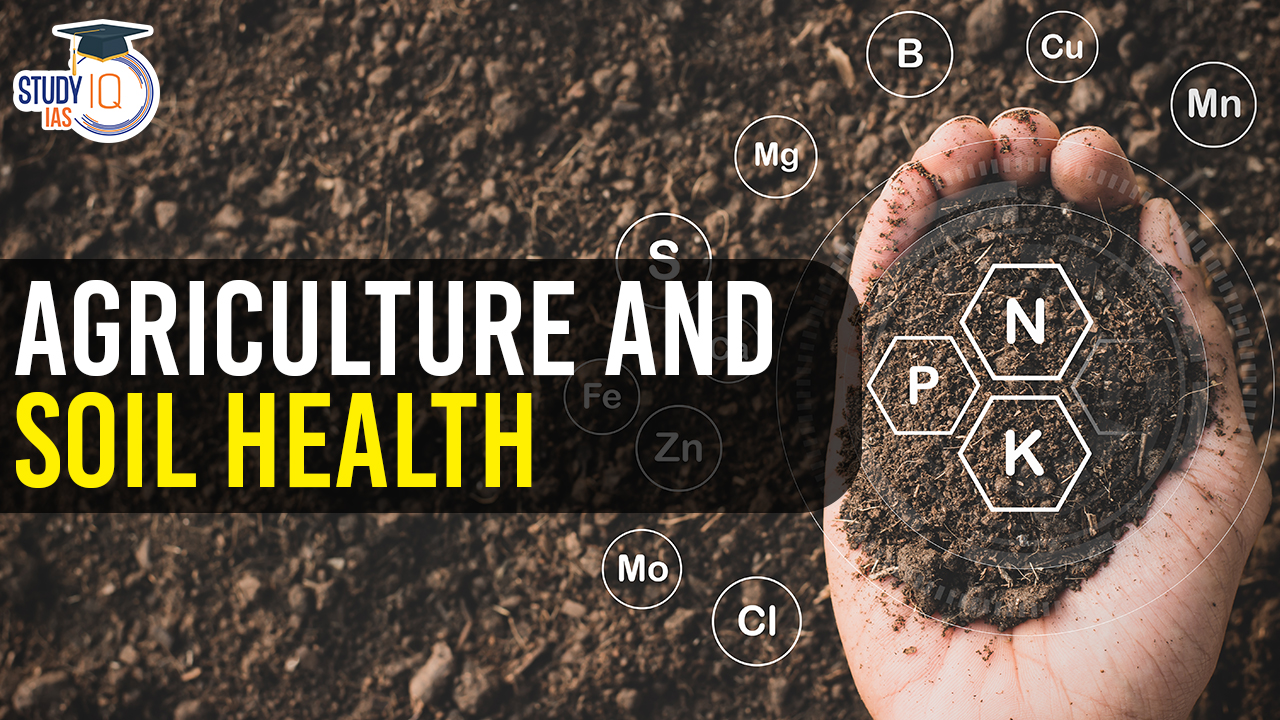Table of Contents
Agriculture and Soil Health
Context: The United Nations celebrates December 5 as World Soil Day to commemorate the birth anniversary of the King of Thailand Bhumibol Adulyadej.
Soil And Agriculture: An Overview
Soil is a naturally occurring, unconsolidated, porous mixture of mineral and organic matter, air, water, and living organisms. It forms the uppermost layer of Earth’s crust and possesses the ability to support rooted plants in a natural environment.

We’re now on WhatsApp. Click to Join
Different Types Of Soil
| Soil Type | Formation | Characteristics | Location | Agricultural Suitability |
| Alluvial Soil | Deposited by rivers and streams | Rich in minerals, organic matter, clay; Moisture-retentive | Indo-Gangetic plains, Brahmaputra valley, coastal plains | Ideal for rice, wheat, sugarcane, pulses, oilseeds, vegetables |
| Black Soil (Regur) | Derived from volcanic lava | Dark, high clay content, rich in calcium, magnesium, iron | Deccan Plateau, Central India | Excellent for cotton; suitable for wheat, jowar, bajra, sugarcane, tobacco |
| Red Soil
(Also known as Omnibus Group) |
Weathered from crystalline rocks like granite and gneiss | Reddish due to iron oxide, sandy loam texture, moderate fertility | Peninsular India, Eastern Ghats, Central India | Suitable for groundnut, millets, pulses, oilseeds, cashew, mango |
| Laterite Soil | High rainfall and temperature leaching nutrients | Reddish-brown, high iron and aluminium, low fertility | Western Ghats, Eastern Ghats, Karnataka, Kerala, Tamil Nadu | Limited; for rubber, cashew, pineapple, coconut with management |
| Mountain Soil | Weathering of rocks in mountainous regions | Shallow, coarse texture, low organic matter | Himalayan region, Western Ghats, Eastern Ghats | Limited; terraced farming of fruits like apples, pears, cherries |
| Arid Soil | In regions with low rainfall and high temperatures | Sandy, low organic matter, high salt concentration | Thar Desert, parts of Rajasthan and Gujarat | Limited; for drought-resistant crops like millet, certain fruits |
| Saline and Alkaline Soils | Accumulation of salts due to poor drainage | High salt content, affects plant growth | Coastal areas, arid and semi-arid regions | Limited without management; for salt-tolerant crops like rice, barley after reclamation |
| Peaty and Marshy Soils | Accumulation of organic matter in waterlogged areas | High organic matter, acidic, poor drainage | Coastal regions, river deltas, high rainfall areas | Limited due to waterlogging, acidity; for crops like cranberries, certain vegetables after drainage and liming |
| Forest Soil | Found under forest vegetation | High organic matter, acidic, good moisture retention | Forested areas throughout India | Limited due to acidity, low nutrients; for crops like tea, coffee after management |
What is Soil Fertility?
- Soil fertility is defined as the ability of soil to provide essential nutrients and create an optimal environment for plant growth.
- Ensuring sufficient soil fertility is key to achieving maximum agricultural output and securing food supply.
- Essential nutrients for plant growth include nitrogen, phosphorus, and potassium, with micronutrients like iron, zinc, and copper needed in smaller amounts.
- Fertile soils contribute to not only higher crop yields but also to the healthy growth of plants and their ability to withstand diseases and various environmental challenges.
Challenges To Soil Fertility
- Overuse of Chemical Pesticides and Fertilizers: The Green Revolution, while boosting food production, also led to the extensive use of chemical pesticides and fertilizers.
- This practice has poisoned fields and crops, leading to the loss of natural nutrients in the soil and contamination.
- Excess fertilizers have also increased nitrate levels in the soil.
- Excessive Farming and Water Table Depletion: Continuous and intensive farming practices have led to the depletion of the water table.
- The provision of free water in many states has resulted in over-irrigation and further depletion of water resources.
- Mining Activities: Mining, especially opencast mining, rapidly degrades land.
- It disturbs the water table, contaminates soil and water, destroys flora and fauna, and produces waste that is often not disposed of scientifically.
- Deforestation and Land-Use Changes: The cutting of forests, both legally and illegally, contributes to soil degradation.
- This leads to soil erosion, especially during rains and floods, as the soil is washed away.
- The loss of forest cover also reduces the soil’s ability to retain water and nutrients.
- Rapid Urbanization and Industrialization: The growth of urban areas and industrial activities has led to soil degradation.
- Untreated sewage and industrial waste released into rivers contaminate the water used for agriculture, further degrading the soil.
- Natural Factors: Natural events like droughts, landslides, and floods exacerbate soil degradation.
- These events can lead to the loss of topsoil and affect the soil’s structure and fertility.
- Shift in Nutrient Sources: In the 1950s, a significant portion of soil nutrients came from organic sources.
- However, there has been a shift towards inorganic fertilizers, with only a small percentage of nutrients now coming from organic sources.
- This change has impacted the soil’s health and fertility.
- Soil Carbon Depletion: Intensive inorganic agricultural practices have led to the depletion of carbon levels in the soil.
- Restoring the soil’s physical, chemical, and biological health is crucial for sustainable agriculture.
- Monoculture Farming: Reduces soil biodiversity and makes soil more vulnerable to pests and diseases.
- Large-scale cultivation of single crops like rice and wheat under the Green Revolution.
Strategies To Combat Soil Degradation
- Conservation Agriculture: This includes practices like no-till farming, using residue mulch, crop rotations, and integrating crops with trees and livestock.
- These methods are aimed at restoring soil nutrients and improving overall soil health.
- Efficient Fertilizer Use: Moving away from the traditional broadcasting of fertilizers, the use of seed-cum-fertilizer drill machines is encouraged. This technique increases water use efficiency and optimises nutrient availability in the soil.
- Cover Crops and Mulching: Utilising cover crops and mulching are effective ways to protect and enrich the soil, helping to retain moisture and prevent erosion.
- Agroforestry: Integrating trees and shrubs into agricultural land not only diversifies the ecosystem but also contributes to soil health and sustainability.
- Smart Soil Systems: Implementing innovative solutions like Bhoomitra and Krishi-RASTAA can enhance soil management and promote sustainable practices.
- Carbon Sequestration Practices: Practices that enhance carbon sequestration in soils are critical for offsetting emissions and restoring degraded soils.
- Crop Diversification: Encouraging the cultivation of a variety of crops can prevent soil depletion and reduce disease and pest infestations.
- Sustainable Rice Cultivation: Transitioning from traditional puddled and flooded rice cultivation to direct-seeded and aerobic methods can significantly reduce water usage and soil degradation.
- Reduced Chemical Use: Focusing on improving soil health naturally reduces the need for chemical inputs and enhances the efficiency of those that are used.
- Precision Agriculture: Leveraging digital innovations, robotics, and artificial intelligence in farming can optimise resource use and improve soil management.
- Reclamation of Degraded Soils: Addressing issues in saline, alkaline, and acidic soils, and supplementing with micronutrients and biofertilizers as needed, is crucial for restoring soil health.
- Integrated Nutrient Management: Combining organic manures with mineral fertilizers can improve both soil health and crop yields.
- Innovative Machinery: Utilising machinery like the happy turbo seeder in the rice-wheat system ensures in-situ conservation of straw, which in turn increases soil organic carbon.
Government Initiatives for Soil And Agriculture
- Paramparagat Krishi Vikas Yojana (PKVY): This scheme promotes organic farming through the adoption of organic village clusters and PGS (Participatory Guarantee System) certification. It aims to improve soil health and organic matter content and increase the net income of the farmer.
- Neem Coating of Urea: To prevent the non-agricultural use of urea and to ensure its availability to genuine farmers, the government of India has mandated neem coating of urea. The neem coating also helps in reducing nitrogen losses from the soil.
- The Nutrient Based Subsidy (NBS) Scheme: This scheme was introduced to promote the use of balanced fertilizers and to limit the overuse of chemical fertilizers. It provides subsidies on key nutrients like Nitrogen (N), Phosphate (P), Potash (K), and Sulphur (S).
- National Mission for Sustainable Agriculture (NMSA): NMSA is part of the National Action Plan on Climate Change (NAPCC) and focuses on enhancing agricultural productivity, especially in rainfed areas focusing on integrated farming, soil health management, and synergizing resource conservation.
- Soil Health Card Scheme: Launched by the Government of India, this scheme aims to provide a Soil Health Card to farmers every two years, which indicates the health of the soil and recommends fertilizers and nutrients to improve soil health.
- Digital Agriculture: This includes a range of technologies such as precision farming, mobile apps, and AI, which aim to optimize field-level management concerning crop farming. It’s a newer initiative that helps in better decision-making for soil health improvement and efficient farm management.
| Soil Conservation Techniques |
Save SoilSave Soil is a global movement launched by Sadhguru, to address the soil crisis by bringing together people from around the world to stand up for Soil Health and supporting leaders of all nations to institute national policies and actions toward increasing the organic content in cultivable Soil. |


 World Day for International Justice 2025...
World Day for International Justice 2025...
 Anusandhan National Research Foundation ...
Anusandhan National Research Foundation ...
 Places in News for UPSC 2025 for Prelims...
Places in News for UPSC 2025 for Prelims...





















